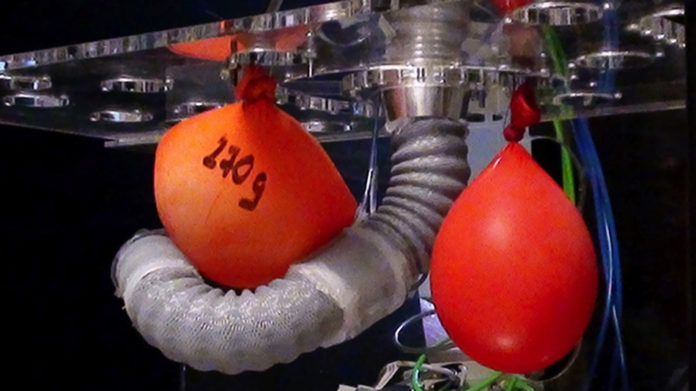Octopus-inspired robotic arms lend a hand in surgery

A robotic arm inspired by octopus tentacles could make it easier for surgeons to access hard-to-reach parts of the body.
A new robotic device uses a series of inflatable chambers to mimic how an octopus can twist, elongate and bend its limbs in any direction. The mechanical arm also imitates the way an octopus can change the stiffness of different sections of its tentacles, allowing the cephalopods to interact with objects.
The device could help make it easier for surgeons to reach parts of the body that are usually tough to access. One section of the robotic arm will then be able to handle soft organs without damaging them while another section operates on the patient.
This technique could reduce the number of instruments needed for surgical procedures, researchers said in a new study detailing the technology. This means doctors will likely need to make fewer entry incisions on patients, lessening the chance of postoperative complications, they added.
“The potential is to allow the performance of current minimally invasive procedures in an easier way for the surgeon, as well as to enable them to perform procedures that are currently not possible in a minimally invasive way with the instrumentation surgeons have today,” said Tommaso Ranzani, a researcher at the Sant’Anna School of Advanced Studies in Italy and lead author of the new study, published on May 14 in the journal Bioinspiration & Biomimetics.
In the study, the researchers described a device consisting of two identical interconnecting modules, each containing a flexible central pipe filled with ground coffee surrounded by three equally spaced cylindrical, air-filled chambers.
This setup was embedded in flexible silicon and surrounded in a plastic sheath that resembles corrugated drain tubing. By inflating different combinations of chambers to varying degrees, the arm was able to move in any direction.
Air can also be sucked out of the central core of each module, making it stiffen thanks to a process called granular jamming, which causes fluid materials, like ground coffee, to become rigid as their density increases.
These aren’t the same mechanisms used by an octopus, but it was the combination of abilities that inspired the researchers, Ranzani said.
“The octopus body has no rigid structures and can thus adapt the shape of its body to its environment,” he said. “The octopus can vary the stiffness of its arms and body, and this endows the arms with the unique ability to form ‘skeletal’ structures that serve both for movement generation and for dynamically reconfiguring the arms’ shape.”
In their study, the researchers demonstrated that the arm could bend to angles of up to 255 degrees, and stretch to up to 62% of its initial length while increasing stiffness by up to 200%.
The researchers also simulated surgical operations and successfully demonstrated the arm’s ability to manipulate water-filled balloons that were used to represent organs.
While flexible surgical robotics are relatively common these days, Ranzani said the new robotic arm stands out because of its soft materials and because of its ability to carry out multiple tasks during an operation.
“It will be able to perform multiple tasks with the same instrument, such as lifting up an organ to expose the target with a portion of the arm and then performing surgery on the now-accessible surgical target,” he said.
The technology behind the device is not new, but its potential application for minimally invasive surgery is both novel and promising, said Kai Xu, a medical robotics expert and assistant professor at the Shanghai Jiao Tong University’s UM-SJTU Joint Institute.
But the device will likely need to be refined before it can be used widely for real-life surgeries, Xu said.
“[T]he working prototype presented in this paper is still relatively large,” Xu said. “It will be very challenging to miniaturize the design while maintaining the payload and motion capabilities to the desired level, not mentioning the sterilizability and other aspects concerning the actual medical practices while using this device.”
To ensure the device is useful for doctors, Ranzani and his colleagues are collaborating with surgical experts from the University of Turin in Italy, and he said future work will focus on determining the optimal number of modules for the arm and providing a reliable and intuitive control system.
“We believe this system will be the start for new and improved versions with more advanced features,” Ranzani said. “Suckers will be something we would love to look into!”
- All 5 of Pluto’s Known Moons Spied by NASA Probe (Photo)
- Curiosity Rover Sees Stunning Blue-Tinted Sunset on Mars (Video)
- Lingering Depression May Double Stroke Risk
- Where Is the Safest Place to Sit on a Train?
This article originally published at LiveScience here

